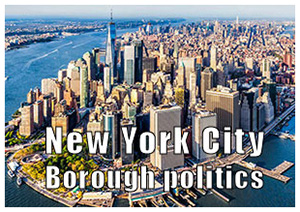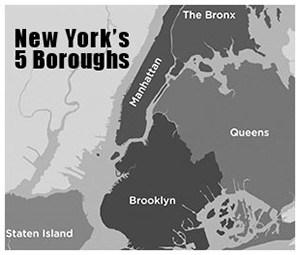LOCAL GOVERNMENT  New York City Boroughs New York City BoroughsBy Andrew Stevens, City Mayors Fellow* ON THIS PAGE: New York City government | NYC’s five boroughs | The Borough presidents | Borough presidents’ salaries | List of 21st NYC Borough presidents ON OTHER PAGES: American mayors | US women mayors ||| Counting Americans | Mayors, parties, politics | The guns of America | US mayors and the mass media | American mayors defend women's right to abortion | US Supreme Court versus City Halls | Corrupt US mayors WORLD MAYOR 2023: The 2023 World Mayor Prize is dedicated to Friendship between Cities. The Honours will be awarded to mayors and cities that have made outstanding contributions to friendship, partnership and cooperation between towns and cities at home and across borders. PLEASE ELECT YOUR CANDIDATES New York’s Borough Presidents: Influential beyond their powers March 2022: Bloomberg, Giuliani, Dinkins, Koch, the roll call of New York City leaders is notable by any city’s standards, as flyers to its LaGuardia airport can attest. Though weighty civic offices in their own right, the presidents of the five boroughs on the other hand enjoy less national or global prominence but possess considerable boss-like patronage and influence over local communities across the city. NYC’s new Mayor Eric Adams served as Brooklyn’s Borough President for two terms from 2013, prior to his election as successor to the term-limited Bill de Blasio last November. New York City government Like many American cities, New York City operates under a strong mayor-council model, though its city council is the nation’s largest with 51 elected members. The city council holds New York’s mayors to account, while also legislating and budgeting over a range of municipal issues across the five boroughs - The Bronx, Brooklyn, Manhattan, Queens and Staten Island. At the last city elections held November 2021, the Democrats achieved an almost clean sweep, with 46 seats of the 51 districts contested, leaving the minority Republicans trailing with just five council members. Operating under its City Charter, as the city government for New York, the council is responsible for a range of local services provided through mayoral agencies (usually overseen by a deputy mayor) in the realm of city planning, public schools, welfare, waste, criminal justice (e.g. probation), parks, policing, among others. It is not responsible for the Port Authority (which administers much of the regional transportation infrastructure) however, as this is a joint venture between the states of New York and New Jersey. The city council owes its origins to the port of New Amsterdam under the Dutch West India Company in 1625, before the emergence of the so-called consolidated New York City in 1898 which covered a wider area than the original settlement and its Common Council and Board of Aldermen (these modelled on the ancient City of London Corporation). The 1898 consolidation principally entailed the amalgamation of a number of separate counties and municipalities into one entity known as New York City, with legislative functions residing with the city council under the new City Charter and a new Board of Estimate created as an administrative agency for the city.  NYC’s five boroughs NYC’s five boroughsThis brings us to the five boroughs themselves, as well as the Board of Estimate. The boroughs came into existence under the 1898 reforms to the city which created the modern-day city council and its associated bodies, spreading the city itself across several distinct separate counties: New York County, Kings County, Queens County and Richmond County. This was followed by the 1899 secession of the eastern portion of Queens to become the new Nassau County outside of the city and the separation of New York County between Manhattan and The Bronx in 1914. The boroughs were fashioned from the old counties and the municipalities they contained into five distinct units within New York City, though they also still exist as counties of New York State for judicial purposes through the election of District Attorneys for each county (to the effect that Manhattan is served by the New York County District Attorney). Richmond was renamed Staten Island in 1975. Under the 1898 reforms to the City Charter, rather than acting as independent sub-municipalities as is the case in other global cities, the five boroughs functioned as integral parts of the city government of New York through the Board of Estimate on which they sat alongside the Mayor, Council President and City Comptroller. The Board exercised considerable jurisdiction over the municipal budget, land use planning and contracts (all notorious aspects of NYC history, from Boss Tweed to Robert Moses) and was further expanded under Mayor Fiorella La Guardia in 1938. As members of the Board, each borough president (BP) had one vote, compared to two for each of the city-wide officials, with its existence deemed unconstitutional following a US Supreme Court ruling in 1989 that the boroughs lacked weighted votes by population in violation of the principle of equal protection under the fourteenth amendment (“one person one vote”). As a consequence, following a city-wide referendum in 1990, carried 55-45, the Board was abolished and its functions folded into the city council, arguably the high watermark for the boroughs and thus curbing their historic powers. Today the boroughs are often seen outside of their geographic and cultural basis as ceremonial units of the wider city administration, not least as some New Yorkers also identify with their neighbourhood within the city overall (e.g. Park Slope or Jackson Heights). While the city council, through the offices of the Mayor, Comptroller and Public Advocate, concerns itself with municipal services across the city, the boroughs are where community politics can happen. In and of themselves, each BP acts as the borough administration, with less in the way of checks and balances as there are no elected borough councils to hold them to account. Instead, each borough has its own board consisting of the BP, local city council members and the heads of each community board in the borough (an office appointed to by the presidents themselves). The boroughs do not levy any local taxes but instead receive five per cent of the New York City Council Capital Grant Program to spend on their own local priorities for capital project funding, cultural organisations and educational programmes. For instance, of the $95.1bn total Budget for the City Council in 2021, just $25m was allocated to the five BPs’ budgetary purview. The main powers of the BPs under the City Charter can be understood as follows: • to lead and represent their borough, speaking up for it within the city government, by using their soft power and “bully pulpit” • to coordinate local action and work by the city council through monthly cabinet meetings of city officials, holding special hearings on local issues as necessary • acting as the community’s voice on land use planning issues (zoning) in the borough when the city council receives proposals for development • appointing members to each of the 59 community boards across the city, as well as members of the City Planning Commission and Board of Education • control their allocated local budget to fund community projects In spite of their relatively narrow powers and resources, the boroughs still offer scope for localised decision-making and influence over the city council, its budget and legislation, compared to other large cities in the US (for instance the 40 non-partisan Advisory Neighborhood Commissions elected under the Washington DC Home Rule Charter). For instance, BPs have the right to propose bills to the city council (though they cannot vote and require a council member to co-sponsor), with this route seeing a number of recent new city laws being introduced, such as former Manhattan BP Gale Brewer’s initiated legislation on extending sick pay and ending discrimination against prospective employees with criminal records. The Borough presidents Of the five, four borough presidents were inaugurated for their first terms in January 2022 following the November 2021 elections in the city. Donovan Richards was elected as Queens BP in November 2020 during a special election to replace Melinda Katz after her successful run for Queens County District Attorney. Four of the five are Democrats and all five have held previous public office as members of the city council. Staten Island’s Vito Fossella is the lone Republican BP, in addition to an earlier stint on the city council he has also represented the city in the US House of Representatives. Vanessa Gibson, the current sole female borough boss, also served one term in the New York State Assembly prior to her election to the city council. BP Gibson is the first female and first African-American to hold the office in The Bronx. Donovan Richards is also African-American, while Antonio Reynoso’s parents are from the Dominican Republic. Manhattan’s Mark Levine is Jewish and though a Republican, Fossella hails from an important Italian political family in New York City politics for the Democratic Party. Levine and Fossella are also the only BPs to have worked professionally outside of politics (teaching and law, respectively). Outside of Staten Island, which has swung between the two parties throughout its existence as a borough, the Democrats largely occupy each of the borough halls. Queens last elected a Republican in 1952, while Manhattan has not had a Republican BP since 1945. Both the late David Dinkins and his close supporter Eric Adams have used the office of borough president as a stepping stone to the mayoralty. Like NYC mayors, each BP is also limited to two terms of office. Salaries The salary for each of the borough presidents is $179,200 a year, increased from $160,000 following a 2016 vote of the New York City Council. For comparison, city council members take home $148,500 while the mayor receives $258,750 annually. The 2016 rises were the first in a decade and also introduced the requirement that city public offices be full-time posts. List of 21st century NYC Borough Presidents
* The research was carried out in February and March 2022 © Copyright: All content of the City Mayors and World Mayor websites are protected by worldwide copyright. Please contact the editor if you wish to use any material from the City Mayors, World Mayor or Women Mayors websites. Follow @City_Mayors |


